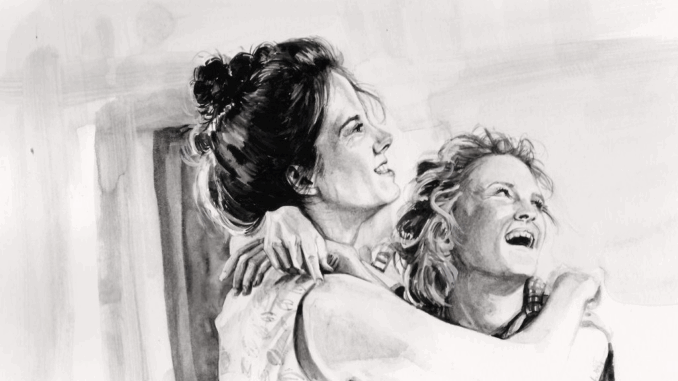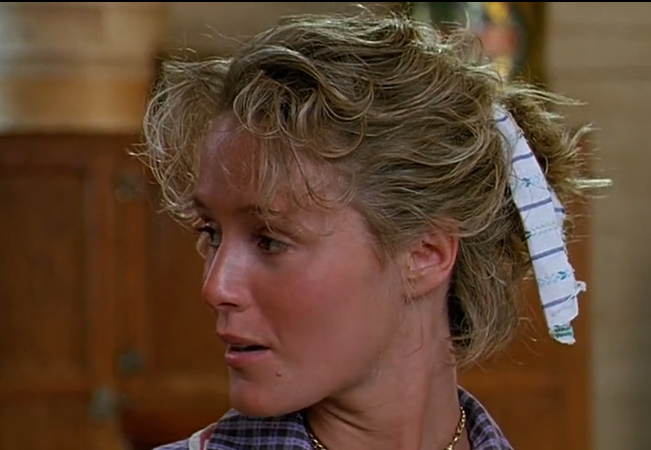
An Unexpected Setting for Devotion
In one of the most visually and emotionally striking scenes of Fried Green Tomatoes, Idgie Threadgoode and Ruth Jamison are seen sharing a picnic—at a graveyard. The location? Buddy Threadgoode’s resting place, beneath the spreading limbs of a peaceful tree. A red checkered cloth, a basket of food, laughter, and quiet conversation set the mood. To an outsider, it might seem morbid or even eccentric. But to these two women, it’s a sacred ritual—one that celebrates memory, love, and the enduring presence of those we’ve lost.
This is not a scene about mourning. It is a scene about continuity. And at its heart lies a profound message: that love doesn’t end at the grave.
Buddy’s Eternal Presence
For Idgie, Buddy’s grave is not a place of sorrow, but a place of closeness. Years have passed since her beloved brother died in a tragic train accident, but her connection to him has never waned. Bringing Ruth to this space signals trust. It’s Idgie inviting Ruth not only into her grief but into her most intimate world.
Here, among the gravestones and quiet wind, Idgie talks about Buddy—not with sadness, but with warmth. She shares stories, memories, and laughter. For her, Buddy lives on in every meal shared at his grave, every laugh under the trees, every visitor who hears his name.
This is how she keeps him alive—not by locking him away in silence, but by making him part of the living world.
Ruth’s Understanding Grows

Ruth, more traditionally inclined, is at first uncertain. She was raised to visit cemeteries with reverence and solemnity. But as she watches Idgie move through this space with ease and tenderness, she begins to understand: this is not about disrespect—it’s about holding on to the good.
This picnic becomes a turning point in Ruth’s understanding of Idgie. She sees that Idgie’s irreverence isn’t emptiness—it’s a defense against heartbreak, a way to laugh through pain, to keep going when others would shut down. In this cemetery, Ruth sees the depths of love that Idgie rarely allows to surface.
And something inside her shifts. She begins to embrace the idea that grief and joy can coexist.
Food as a Language of Love
The food in this scene isn’t just nourishment—it’s storytelling. Sandwiches, fried green tomatoes, sweet tea—each bite carries memory. For Idgie, preparing the food is like writing a letter to Buddy. For Ruth, eating with Idgie at the grave is a quiet way of saying: I’m here. I honor your loss. I honor you.
The picnic acts as both communion and confession. There are no grand declarations, but the emotions run deep. Ruth’s presence is a reassurance that Idgie doesn’t have to carry her pain alone. And Idgie’s invitation is an opening, letting Ruth into a part of her life that is deeply sacred.
It’s a love scene—but one without romance or fireworks. It’s about spiritual intimacy. About sharing grief, memory, and the simple beauty of sitting side by side.
Redefining Family and Memory
This scene challenges traditional ideas of family and mourning. Rather than visiting a grave once a year and offering flowers, Idgie lives with the dead as part of her everyday life. Buddy’s presence isn’t restricted to photographs or church services—he is invited to lunch, remembered in laughter, and included in stories.
Through this act, Idgie and Ruth demonstrate that family isn’t about blood or formality—it’s about connection and choice. They choose to make Buddy part of their continuing journey. And in doing so, they show that the dead are not truly gone if they are still remembered, still celebrated.
This redefinition of family, grief, and tradition is central to the themes of Fried Green Tomatoes. The graveyard picnic is its quiet embodiment.
The World Outside vs. the World They Build
While the outside world demands mourning to look a certain way—stoic, silent, dressed in black—Idgie and Ruth build a new world within the bounds of Whistle Stop. A world where grief is allowed to smile, where love is expressed through care, where life and death are woven together in daily rituals.
This picnic defies convention. And in doing so, it becomes a deeply feminist and deeply human moment. These two women reclaim a space often defined by masculine authority—cemeteries, grief, religion—and make it their own. They don’t ask permission. They simply love.
Legacy and Living On
By the end of the scene, as the sun filters through the trees and the women pack up their things, we are left with a sense of peace. Buddy is not mourned in absence but included in presence. The grave is not a barrier—it is a bridge.
This picnic, repeated over the years, becomes a symbol of endurance. Idgie and Ruth continue to visit Buddy. They bring his memory to life over and over again. And in doing so, they teach us a vital truth: that memory is an act of love. That remembrance can be joyful. That loss does not end the story.
Conclusion: A Feast of Memory and Love
The graveyard picnic in Fried Green Tomatoes is more than an eccentric habit. It is a deeply emotional and symbolic moment that encapsulates the film’s greatest themes: love that transcends death, chosen family, and the healing power of memory.
In this one scene, we see how grief can be softened by ritual, how loss can be transformed into storytelling, and how love can live on in the spaces we choose to honor it.
Idgie doesn’t just visit her brother’s grave—she lives with him, speaks to him, laughs with him. And in doing so, she shows Ruth, and us, that the most powerful relationships never truly end. They simply change form.
